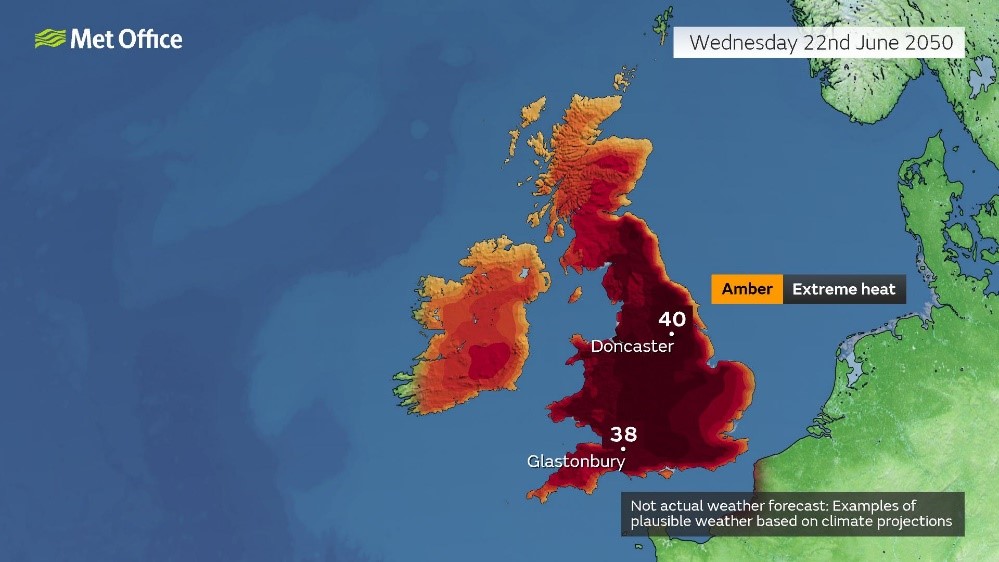Met Office
|
|
How we make our 2050 ‘forecasts’, and why we do them
You may have seen some of our forecasts that look a little further ahead than you would usually expect. Although they use the same graphics as our normal weather forecasts, we’ve been producing theoretical ‘forecasts’ for 2050 to look at what conditions we could expect to see in the UK if global greenhouse gas emissions continue to rise.
One of the greatest challenges with communicating the risks of climate change is how to show, in a relatable way, how changes in our atmosphere could impact the weather we experience on the Earth’s surface. By showing what the weather could look like by 2050 at certain times of year, it helps people relate to how different their experiences might be under a changing climate.
To date we’ve produced plausible scenarios for a July 2050 heatwave, Wimbledon and Christmas 2054, and now we’ve examined how Glastonbury could look in 30 years’ time.
Plausible scenarios
The key aspect to these ‘forecasts’ is that they are plausible weather events for 2050. Of course, it isn’t possible to create a genuine weather forecast for 2050, however it is possible to generate a realistic forecast based on the atmospheric conditions projected for the future.
The future forecasts are based on climate projections using a high-emissions scenario. One of the biggest sources of uncertainty in climate change is how much the world manages to reduce greenhouse gas emissions in the years to come. That’s why climate scientists model future global warming under various scenarios.
Although these forecasts use one of the higher emission scenarios (RCP8.5), in the middle of the century – where we are focusing – the difference in climate response between scenarios is much less than later in the century when the benefits of mitigation actions taking place now become much more apparent.
Extracting the data
Using Met Office climate modelling expertise, we can look to the future and provide data to our presenting team who generate the graphics to accompany the outlook.
Dr James Pope, a member of the Met Office UK Climate Projections (UKCP) team, explains how this works:
“Using our latest UKCP18 climate projections for the UK, we can examine in detail the various model runs for a specific period in time. Because the climate model works in the same way as our weather forecasting model, we can look at specific dates of interest – for example when Wimbledon usually occurs, or Christmas Day.
“In this example we’ve looked at 22-26 June 2050, the time of year when Glastonbury usually takes place. We can then assess the various model runs, as there are multiple outputs which are based on slightly different atmospheric conditions, to see if there are any notable weather events at that time of year.
“The output from one such model run showed a significant heatwave, with daytime temperatures reaching 38°C and overnight temperatures never getting below 23°C. As such, the ‘forecast’ that we are generating for 2050 is a plausible scenario that, depending on future greenhouse gas emissions, could happen in the future.”
Presenting the future
Once James has downloaded the relevant data, he passes it on to Met Office Presenter Aidan McGivern who then uses our visualisation software to generate the presented forecast.
Aidan explains more:
“Because the climate model works in the same way as our operational weather model, we can input data from our climate projections and display it like a normal weather forecast. By using the same colour palette as the current operational forecasts, it helps to show the intensity of the heat that we could realistically see by 2050.

Map of the UK showing the visualisation of the climate data in a weather forecast format, with clear notes that it isn’t an actual weather forecast.
“When scientists talk about 1°C or 1.5°C of global warming it might not sound like much, but there are wider impacts on our weather system as a consequence of climate change. Linking these ‘forecasts’ to national events makes climate change very real. In this example daytime highs of 38°C would be extremely uncomfortable in a festival environment, and with temperatures never dipping below 23°C at night there is no relief from the heat, conditions that can pose significant health risks.
“It’s really important to make sure that people understand that this is not a real forecast, but a possible scenario for the future. Consequently, we mark up the graphics that show up behind me with very clear dates and a note that this is not an actual weather forecast! I always include an explanation at the end of the videos discussing how we make the videos, why they are plausible scenarios and how things could be different if swift action is taken to lower greenhouse gas emissions.”

Met Office Presenter Aidan McGivern in the studio recording the 2050 ‘forecast’
So that’s how it’s done and why we do it. Here’s the latest example that James and Aidan have created for what Glastonbury 2050 could look like if greenhouse gas emissions continue to rise.
Original article link: https://blog.metoffice.gov.uk/2022/06/23/how-we-make-our-2050-forecasts-and-why-we-do-them/
.gif)

.gif)